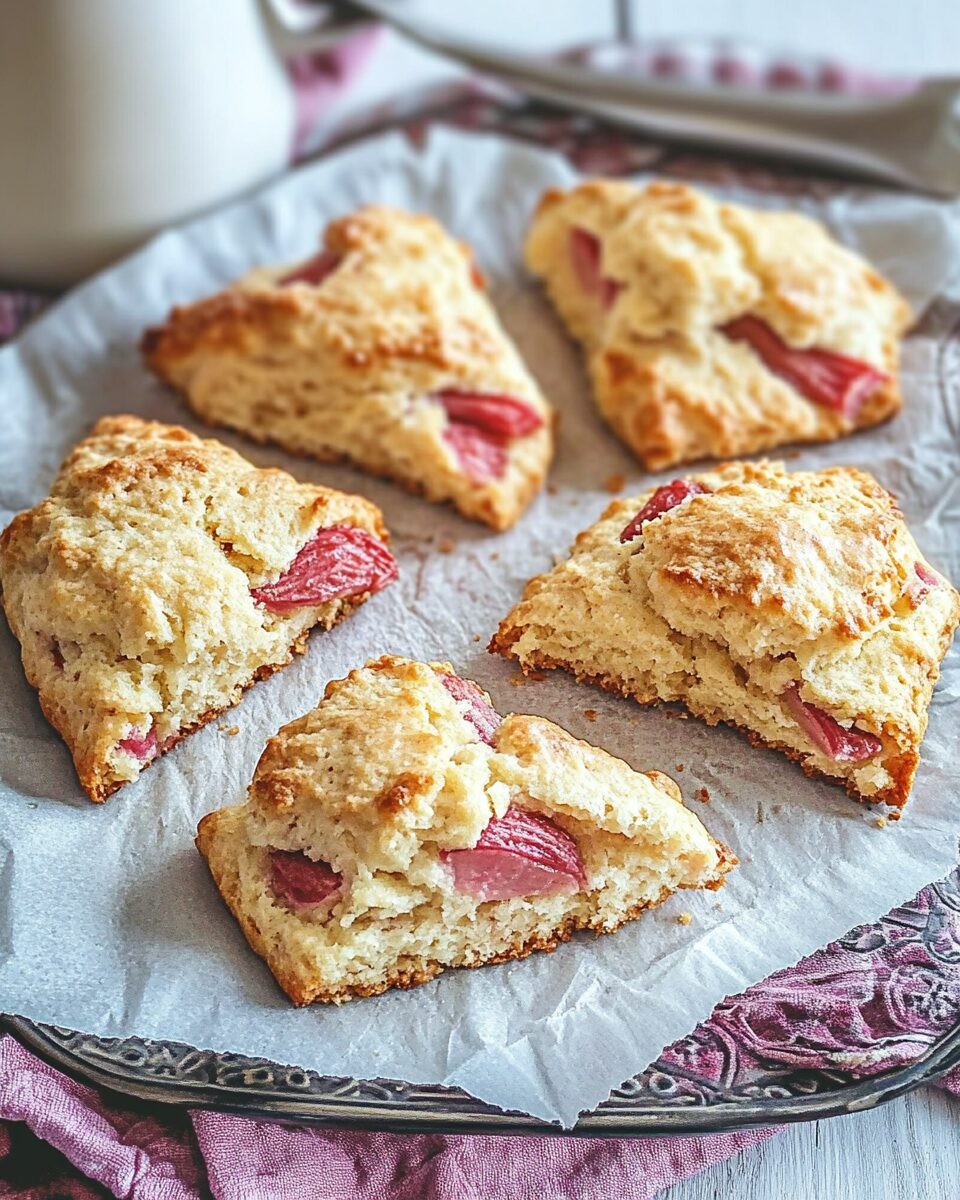The magic of spring shines through in every bite of these rhubarb scones. With tender crumb, pops of tart rhubarb, and bright orange zest, this baked treat is perfect for cozy mornings or elegant brunches. The simple ingredients come together in a rustic, homemade fashion that delivers both flavor and nostalgia.
Whether served warm with a dollop of clotted cream or enjoyed plain alongside your morning coffee, these scones are sure to be a seasonal favorite. Their slightly crunchy sugar tops and soft interior make them an irresistible bake for rhubarb lovers and baking enthusiasts alike.
Full Recipe
Ingredients:
-
2 cups all-purpose flour
-
1/4 cup granulated sugar
-
1 tablespoon baking powder
-
1/2 teaspoon salt
-
6 tablespoons cold unsalted butter, cubed
-
1 cup diced fresh rhubarb
-
1 teaspoon orange zest
-
2/3 cup heavy cream
-
1 teaspoon vanilla extract
-
1 tablespoon coarse sugar (optional, for topping)
Directions:
-
Preheat oven to 400°F (200°C) and line a baking sheet with parchment paper.
-
In a large mixing bowl, whisk together flour, sugar, baking powder, and salt.
-
Cut in the cold butter using a pastry cutter or your fingers until the mixture resembles coarse crumbs.
-
Stir in diced rhubarb and orange zest.
-
In a separate bowl, combine cream and vanilla. Gradually add wet ingredients to the dry ingredients, mixing just until a dough forms.
-
Turn dough out onto a floured surface and knead gently 2-3 times.
-
Pat into a circle about 3/4-inch thick and cut into 8 wedges.
-
Place on prepared baking sheet and sprinkle with coarse sugar, if using.
-
Bake for 18–22 minutes, or until golden brown. Let cool slightly before serving.
Prep Time: 10 minutes | Cooking Time: 20 minutes | Total Time: 30 minutes
Kcal: 260 kcal | Servings: 8 scones
A Celebration of Spring Baking: Rhubarb Scones
Rhubarb is one of those ingredients that marks the arrival of spring like few others can. With its beautiful crimson stalks and uniquely tart flavor, it’s the kind of produce that feels both nostalgic and refreshing. When combined with the soft, buttery crumb of a well-made scone, rhubarb transforms into a vibrant, lightly sweetened treat that evokes memories of countryside kitchens and warm, lazy weekends. These rhubarb scones are more than just a baked good—they’re a celebration of seasonality, simplicity, and comfort.
Why Rhubarb is a Star Ingredient
Despite its vegetable status, rhubarb is often treated like a fruit in desserts and pastries due to its bright acidity and firm texture. It’s the perfect foil to sugar and dairy, making it a natural pairing for scones, cakes, and crumbles. When baked into these scones, rhubarb releases its juices just enough to soften slightly while still holding its shape. This results in pockets of tartness throughout each scone that cut beautifully through the richness of the dough.
In addition to its flavor, rhubarb also adds a stunning visual element. The bright pinks and reds speckled throughout the golden scone create a visually appealing bake that’s as beautiful on a brunch table as it is comforting on a quiet morning.
The Role of Citrus in Elevating the Flavor
One of the most delightful twists in this rhubarb scone recipe is the addition of orange zest. The citrusy brightness complements the rhubarb’s natural tang and elevates the overall flavor profile of the scone. Orange zest offers a subtle aroma that enhances the scones without overpowering them, bringing a floral, sun-kissed edge that balances perfectly with the tartness of rhubarb.
Citrus in baking has always been a secret weapon—it brings lightness and complexity to otherwise rich or dense baked goods. In this recipe, it creates a perfect harmony between brightness and warmth, making each bite layered and nuanced.
The Texture: A Flaky, Buttery Dream
The ideal scone has a tender crumb, a golden crust, and just the right amount of flakiness. Achieving that balance depends on how you incorporate the butter and handle the dough. The cold butter creates steam while baking, leading to that characteristic flake and lift. Overworking the dough, on the other hand, can lead to tough, dry scones—so gentle handling is key.
When done right, you’re rewarded with a scone that’s crispy on the outside, soft and moist on the inside, and studded with juicy chunks of rhubarb in every bite. Whether you eat them warm with a pat of butter or at room temperature with your favorite tea, these scones are deeply satisfying.
Perfect for Brunch, Snacks, or Gifting
One of the joys of baking scones is how versatile they are. Rhubarb scones are ideal for a spring brunch, especially when paired with clotted cream, whipped butter, or even a spoonful of orange marmalade to echo the zest in the dough. They also make an excellent gift—wrapped in parchment and tied with twine, they become a heartfelt homemade treat perfect for birthdays, housewarmings, or as a thank-you to a friend.
Because they’re easy to transport and remain delicious even a day or two after baking, these scones can be part of a picnic basket or lunchbox. Their visual appeal and balanced flavor make them as impressive as they are approachable.
Tips for Success and Variations
For best results, always start with fresh, crisp rhubarb. If your stalks are particularly thick, you may want to slice them in half lengthwise before dicing to ensure even baking. Chilling your dough before baking will help the scones hold their shape and achieve a better rise.
This recipe is also highly adaptable. You could swap the orange zest for lemon for a sharper citrus note or add a handful of chopped strawberries for a classic strawberry-rhubarb combination. For an added touch of indulgence, try drizzling a simple glaze made from powdered sugar and orange juice over the scones once cooled.
If you follow a plant-based or dairy-free lifestyle, you can substitute the cream with coconut cream and use a vegan butter alternative. The results are just as satisfying and still bursting with seasonal flavor.
The Importance of Seasonal Baking
Baking with the seasons is a wonderful way to connect with nature’s rhythms and bring a sense of grounding to your kitchen. Rhubarb is a fleeting treasure—it typically makes its appearance in early spring and disappears by mid-summer. Incorporating it into your baking while it’s fresh not only ensures the best flavor but also encourages mindfulness and creativity in the kitchen.
Rhubarb’s brief window of availability makes recipes like this feel extra special. They’re the kinds of treats that become annual traditions, eagerly anticipated and savored when the time finally comes.
Pairings and Serving Ideas
Rhubarb scones are best enjoyed fresh out of the oven with a steaming mug of tea or coffee. For a more decadent experience, try serving them with a dollop of whipped mascarpone or crème fraîche and a drizzle of honey.
For a brunch spread, you can pair them with savory items like soft scrambled eggs, smoked salmon, or a spring vegetable frittata. Their lightly sweet profile makes them a great counterbalance to more savory dishes. And if you’re hosting afternoon tea, these scones absolutely belong on the tiered tray, alongside cucumber sandwiches and petit fours.
Storage and Make-Ahead Tips
While rhubarb scones are best enjoyed the day they’re made, they will stay fresh for up to two days when stored in an airtight container at room temperature. You can also freeze them—just wrap individually in plastic wrap, place in a freezer-safe bag, and freeze for up to 2 months. To reheat, simply pop them in a 350°F (175°C) oven for 8–10 minutes.
Another make-ahead option is to prepare and shape the dough, then freeze the unbaked scones on a baking tray. Once frozen solid, transfer them to a freezer bag. Bake straight from frozen, adding a couple of extra minutes to the baking time.
Conclusion
These rhubarb scones aren’t just about taste—they’re a reflection of time, place, and care. Every element, from the seasonal produce to the gentle zest of orange and the rich, crumbly dough, tells a story of spring’s awakening and the joy of creating something beautiful and delicious from simple ingredients.
Whether you’re an experienced baker or someone just starting to explore seasonal baking, this recipe offers the perfect opportunity to slow down, appreciate the beauty of fresh produce, and savor the small pleasures of life—one scone at a time.
Let this recipe become part of your spring tradition, bringing joy to your mornings, delight to your gatherings, and a sense of home to your table.






